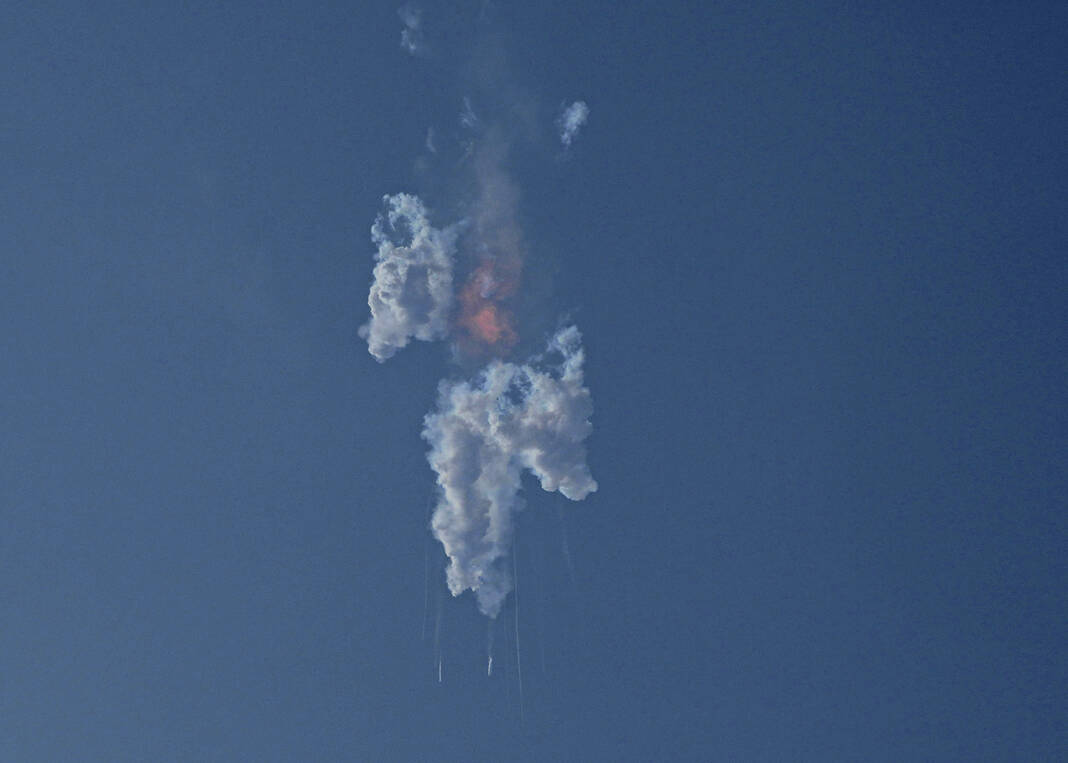
SpaceX’s Starship launches from Starbase in Boca Chica, Texas, Thursday, April 20, 2023. The giant new rocket exploded minutes after blasting off on its first test flight and crashed into the Gulf of Mexico.
AP Photo | Eric Gay

A view of SpaceX Starship rocket from Texas State Highway 48 as Starship launches from Star Base, Texas near Boca Chica Beach soon after exploding after liftoff Thursday morning.
Miguel Roberts | The Brownsville Herald
By Steve Clark
Brownsville Herald Staff Writer
On Thursday, the tallest, most powerful rocket ever to fly lifted off from SpaceX’s Boca Chica/Starbase launch site 22 miles east of Brownsville as the crow flies, reaching an altitude of approximately 26 miles and a speed of more than 1,340 mph before exploding over the Gulf of Mexico three minutes and 59 seconds into the flight — a success, in other words, from SpaceX’s perspective.
The uncrewed mission was the company’s first attempt at an orbital Starship flight, and the first flight at Boca Chica since the successful high-altitude launch and landing of a full-size, three-engine Starship (SN15) almost two years ago.
A launch scheduled for April 17 was scrubbed due to a frozen value.
Kate Tice, a SpaceX quality systems engineer narrating SpaceX’s livestream of the launch, said the fact that Thursday’s test lasted as long as it did is cause for celebration.
“Everything after clearing the (launch) tower was icing on the cake,” she said as Starship SN24 and Super Heavy BN7 disintegrated in what is ironically referred to in the space industry as RUD, or Rapid Unscheduled Disassmbly.
It’s unclear whether the explosion was intentional, caused by the ship’s onboard Flight Termination System.
The Super Heavy’s 33 engines, capable of producing more than 16 million pounds of thrust, were ignited at 8:33 a.m., sending up a colossal dust plume from which the 394-foot-tall rocket emerged atop a column of orange flame, the booster’s silver exterior coated in condensation frost from the roughly 10 million pounds of super-chilled liquid methane and liquid oxygen propellant on board.
The vehicle passed a major test by surviving the period of maximum aerodynamic pressure, or Max Q, when mechanical stresses on the structure are most extreme, though the booster (stage one) failed to separate from the six-engine Starship (stage two), something that should have happened around the three-minute mark.
Instead, the vehicle began to spin slowly and lose altitude after performing a related maneuver.
“We saw the start of the flip, but obviously, we’re seeing from the ground cameras the entire Starship stack continuing to rotate,” SpaceX Principal Integration Engineer John Insprucker said three minutes and 30 seconds into the flight. “We should have had separation by now. Obviously, this does not appear a nominal situation.”
The mission called for Super Heavy to land hard in the Gulf about 20 miles offshore following separation, and for Starship, engines lit, to orbit the Earth once, then splash down hard in the ocean 60 miles north of Kauai, Hawaii, in the Navy’s Pacific Missile Range Facility.
SpaceX said there would be no attempt to recover either stage as part of the first orbital test flight, though Starship-Super Heavy is being developed for rapid reusability, initially to carry people and cargo to Earth destinations and eventually to the moon and Mars.
SpaceX has a $2.9 billion contract with NASA to develop Starship as the Human Landing System (HLS) that will put U.S. astronauts back on the moon for the first time since 1972 as part of the space agency’s Artemis program.
In November, NASA announced a $1.15 billion modified contract containing “Option B,” which involves a more advanced iteration of the Starship HLS for a second crewed demonstration moon landing.
Last year, the Boca Chica/Starbase production facility built four Super Heavy boosters, five Starships and SpaceX’s 200th Raptor 2 engine.
For 2023, the company plans to build five boosters and eight Starships at Boca Chica, Tice said. Musk has said Starship probably will fly hundreds of uncrewed missions before it carries humans for the first time.
Meanwhile, SpaceX will use the telemetry data collected during Thursday’s brief flight — data on the rocket’s position, heading, systems operation and so on — to improve the odds of success the next time around.
“Congrats SpaceX team on an exciting test launch of Starship! Learned a lot for the next test launch in a few months,” he tweeted after the flight.
Musk had set expectations low for the first test, estimating the chances of making it into orbit the first time around at roughly 50 percent.
“If we do launch, I would consider anything that does not result in the destruction of the launch mount itself, the launch pad, … to be a win,” he said during an April 16 Twitter Spaces meeting with subscribers.

